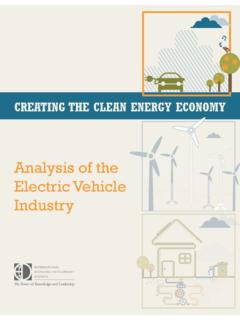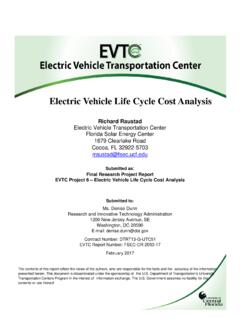Transcription of ARTICLE 625 Electric Vehicle Charging and Supply Equipment ...
1 ARTICLE 625 Electric Vehicle Charging and Supply Equipment Systems I. General Scope. The provisions of this ARTICLE cover the electrical conductors and Equipment external to an Electric Vehicle that connect an Electric Vehicle to a Supply of electricity by conductive or inductive means, and the installation of Equipment and devices related to Electric Vehicle Charging . Informational Note : For industrial trucks, see NFPA 505-2011, Fire Safety Standard for Powered Industrial Trucks Including Type Designations, Areas of Use, Conversions, Maintenance, and Operation. (1)Informational Note No. 2: UL 2594-2011, Standard for Electric Vehicle Supply Equipment , is a safety standard for Electric Vehicle Supply Equipment . UL 2202-2009, Standard for Electric Vehicle Charging System Equipment , is a safety standard for Electric Vehicle Charging Equipment . Definitions. Electric Vehicle . An automotive-type Vehicle for on-road use, such as passenger automobiles, buses, trucks, vans, neighborhood Electric vehicles, Electric motorcycles, and the like, primarily powered by an Electric motor that draws current from a rechargeable storage battery, fuel cell, photovoltaic array, or other source of Electric current.
2 Plug-in hybrid Electric vehicles (PHEV) are considered Electric vehicles. For the purpose of this ARTICLE , off-road, self-propelled Electric vehicles, such as industrial trucks, hoists, lifts, transports, golf carts, airline ground support Equipment , tractors, boats, and the like, are not included. (2) Electric Vehicle Charging System. A system of components that provide a dc output that is supplied to the Vehicle for the purpose of recharging Electric Vehicle storage batteries. Electric Vehicle Connector. A device that, by insertion into an Electric Vehicle inlet, establishes an electrical connection to the Electric Vehicle for the purpose of power transfer and information exchange. This device is part of the Electric Vehicle coupler. Informational Note: For further information, see for interactive systems. Electric Vehicle Coupler. A mating Electric Vehicle inlet and Electric Vehicle connector set. Electric Vehicle Inlet. The device on the Electric Vehicle into which the Electric Vehicle connector is inserted for power transfer and information exchange.
3 This device is part of the Electric Vehicle coupler. For the purposes of this Code, the Electric Vehicle inlet is considered to be part of the Electric Vehicle and not part of the Electric Vehicle Supply Equipment . Informational Note: For further information, see for interactive systems. (13) Electric Vehicle Nonvented Storage Battery. A hermetically sealed battery, comprised of one or more rechargeable electrochemical cells, that has no provision for the release of excessive gas pressure during normal Charging and operation, or for the addition of water or electrolyte, or for external measurements of electrolyte specific gravity. Electric Vehicle Supply Equipment . The conductors, including the ungrounded, grounded, and Equipment grounding conductors and the Electric Vehicle connectors, attachment plugs , and all other fittings, devices, power outlets, or apparatus installed specifically for the purpose of transferring energy between the premises wiring and the Electric Vehicle .
4 Informational Note: For further information, see for interactive systems. (3) Electric Vehicle Supply Equipment System. A system of components that provide an ac output that is supplied to the Vehicle for the purpose of providing input power to an on-board charger. Personnel Protection System. A system of personnel protection devices and constructional features that when used together provide protection against Electric shock of personnel. Plug-In Hybrid Electric Vehicle (PHEV). A type of Electric Vehicle intended for on-road use with the ability to store and use off- Vehicle electrical energy in the rechargeable energy storage system, and having a second source of motive power. Rechargeable Energy Storage System. Any power source that has the capability to be charged and discharged. Informational Note: Batteries, capacitors, and electromechanical flywheels are examples of rechargeable energy storage systems. Voltages. Unless other voltages are specified, the nominal ac system voltages of 120, 120/240, 208Y/120, 240, 480Y/277, 480, 600Y/347, and 600 volts and DC system voltages of up to 600 volts(4) shall be used to Supply Equipment covered by this ARTICLE .
5 Listed or Labeled(5). All electrical materials, devices, fittings, and associated Equipment shall be listed or labeled. II. Wiring Methods Equipment Construction 10 Electric Vehicle Coupler. The Electric Vehicle coupler shall comply with (A) through (F). (A) Polarization. The Electric Vehicle coupler shall be polarized unless part of a listed Electric Vehicle Charging system or an Electric Vehicle Supply Equipment system identified and listed as suitable for the purpose(6). (B) Noninterchangeability. The Electric Vehicle coupler shall have a configuration that is noninterchangeable with wiring devices in other electrical systems. Nongrounding-type Electric Vehicle couplers shall not be interchangeable with grounding-type Electric Vehicle couplers. (C) Construction and Installation. The Electric Vehicle coupler shall be constructed and installed so as to guard against inadvertent contact by persons with parts made live from the Electric Vehicle Supply Equipment or the Electric Vehicle battery.
6 (D) Unintentional Disconnection. The Electric Vehicle coupler shall be provided with a positive means to prevent unintentional disconnection. (E) Grounding Pole(6,7). The Electric Vehicle coupler shall be provided with a grounding pole, unless provided as part of a listed isolated Electric Vehicle Charging system identified and listed as suitable for the purpose in accordance with ARTICLE 250. (F) Grounding Pole Requirements. If a grounding pole is provided, the Electric Vehicle coupler shall be so designed that the grounding pole connection is the first to make and the last to break contact. Rating(8). Electric Vehicle Supply Equipment shall have sufficient rating to Supply the load served. For the purposes of this ARTICLE , eElectric Vehicle Charging loads shall be considered to be continuous loads for the purposes of this ARTICLE . Where an automatic load management system is used, the maximum Electric Vehicle Supply Equipment load on a service or feeder shall be the maximum load permitted by the automatic load management system.
7 Markings. The Electric Vehicle Supply Equipment shall comply with (A) through (C). (A) General. All Electric Vehicle Supply Equipment shall be marked by the manufacturer as follows: FOR USE WITH Electric VEHICLES (B) Ventilation Not Required. Where marking is required by (C), the Electric Vehicle Supply Equipment shall be clearly marked by the manufacturer as follows: VENTILATION NOT REQUIRED The marking shall be located so as to be clearly visible after installation. (C) Ventilation Required. Where marking is required by (DB), the Electric Vehicle Supply Equipment shall be clearly marked by the manufacturer, Ventilation Required. The marking shall be located so as to be clearly visible after installation. Means of Coupling. The means of coupling to the Electric Vehicle shall be either conductive or inductive. Attachment plugs , Electric Vehicle connectors, and Electric Vehicle inlets shall be listed or labeled for the purpose. Cords and Cables. (9)(A) Power Supply Cord.
8 The cable for cord-connected Equipment shall comply with all of the following: (1) Be any of the types specified in (B)(1) or Hard Service Cord, Junior Hard Service Cord and Portable Power Cable types in accordance with Table Hard Service Cord, Junior Hard Service Cord and Portable Power Cable types shall be listed, as applicable, for exposure to oil and damp and wet locations. Exception: A power Supply cord that is listed as a part of the Electric Vehicle Supply Equipment or Electric Vehicle Charging system. (2) Have an ampacity as specified in Table (A)(1) or, for 8 AWG and larger, in the 60 C columns of Table (A)(2). (3) Have an overall length as specified in (a) or (b): (a) When the interrupting device of the personnel protection system specified in is located within the enclosure of the Supply Equipment or Charging system, the power Supply cord shall be no more than 300 mm (12 in.) long, (b) When the interrupting device of the personnel protection system specified in is located at the attachment plug, or within the first 300 mm (12 in.)
9 Of the power Supply cord, the overall cord length shall be a minimum of m (6 ft) and shall be no greater than m (15 ft). (B) Output Cable to the Electric Vehicle . The output cable to the Electric Vehicle shall comply with all of the following: (1) Be Type EV, EVJ, EVE, EVJE, EVT, or EVJT flexible cable as specified in Table (2) Have an ampacity as specified in Table (A)(1) or, for 8 AWG and larger, in the 60 C columns of Table (A)(2). Exception to (2): An output cable to the Electric Vehicle that is listed as a part of the Electric Vehicle Supply Equipment or Electric Vehicle Charging system. Informational Note: Listed Electric Vehicle Supply Equipment or Electric Vehicle Charging system may incorporate output cables having ampacities greater than 60C based on the permissible temperature limits for the components and the cable. (C) Overall Cord and Cable Length. The overall useable length shall not exceed m (25 ft) unless equipped with a cable management system that is part of a listed the Electric Vehicle Supply Equipment or Electric Vehicle Charging system.
10 (1) Where the Electric Vehicle Supply Equipment or Charging system is not fixed in place, the cord exposed useable length shall be measured from the face of the attachment plug to the face of the Electric Vehicle connector. (2) Where the Electric Vehicle Supply Equipment or Charging system is fixed in place, the useable length of the output cable shall be measured from the cable exit of the Electric Vehicle Supply Equipment or Charging system to the face of the Electric Vehicle connector. Other cable types and assemblies listed as being suitable for the purpose, including optional hybrid communications, signal, and composite optical fiber cables, shall be permitted. Interlock. Electric Vehicle Supply Equipment shall be provided with an interlock that de-energizes the Electric Vehicle connector and its cable whenever the electrical connector is uncoupled from the Electric Vehicle . An interlock shall not be required for portable cord-and-plug-connected Electric Vehicle Supply Equipment intended for connection to receptacle outlets rated at 125 volts, single phase, 15 and 20 amperes.
















